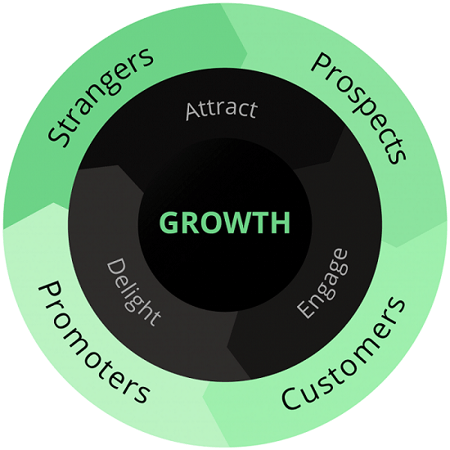Marketers might say they want to create customer-centric marketing — but until we stop viewing journeys as one-way tracks towards desired actions, it’s not going to happen.
We need to stop thinking about how we can steer customers towards the bottom of a funnel, and start meeting them where they want to be met.
So, it’s time to lift the filter of funnel vision and move to an approach that’s about symbiotic success: the Flywheel model.
Flywheel Vs. Funnel: What’s the difference?
What is the funnel?
Over 100 years ago, Elias St. Elmo Lewis created the “AIDA” funnel model highlighting the stages of a customer’s journey with a business.
- Awareness: The prospect is aware of their problems and possible solutions for them.
- Interest: The prospect shows interest in a group of services or products.
- Desire: The prospect begins to evaluate a certain brand.
- Action: The prospect decides whether to purchase.
What is the flywheel?
The flywheel model shows that long-term growth is fueled by the momentum that comes from steadily delivering great marketing and keeping customers happy. To ensure lasting success and win all-important advocacy, marketers must work to constantly entice, captivate, and delight individuals in whichever way is best for them.

Why should marketers trade in the funnel model?
At the turn of the 20th century when the funnel was new, the dynamic between customer and business looked very different. Businesses controlled how their products were introduced and every interaction that followed; customers saw attention-grabbing ads, reached out to companies, and were told where and what to buy.
Today’s customers want to make their own choices. They expect a more personal, consistent, and two-way connection with brands. Yet marketers continue building strategies pushing them along this outdated funnel, often only to find their journey screeches to a halt at conversion.
How does the flywheel work?
So, happy customers drive momentum — but how can marketers get that momentum going?
Think of the flywheel approach like a racecar. To reach maximum pace, it needs energy, yes. But it also needs minimal friction. This means marketers need to focus on both of these, by persistently tapping engagement accelerators and removing blockers in their customer journey. While specific adjustments are going to look different from one company to the next, using real-time customer insight to guide fine-tuning is essential.
Running granular and ongoing performance assessments will help marketers to identify which messages, offers or tactics are working best. Companies should focus on dialing these up to make journeys easier, more enjoyable, and in turn, quicker. Having a clear view of marketing activities will also help marketers pinpoint what’s causing loss of traction, and rectify this. When experiences are smooth and valuable for customers, the whole flywheel spins faster for everyone.
What might cause friction in the customer journey?
While some issues might be easier to pinpoint, like for example frequency caps for ads being set too high, so that customers feel bombarded with the same promotions — it’s also possible that there are foundational challenges putting the brakes on the flywheel.
Recent research has discovered that 67% of CMOs feel overwhelmed by the quantity of data available to them. Crucially, for those who struggle without a unified customer view, there is a higher chance of disjointed experiences and friction. Marketers are drowning in disordered information, and this is because they’re lacking a simpler way to combine everything into one clear view.
Conclusion
The flywheel aims to bring teams together to engage, attract and delight their customers. But before companies can do this, they need to take stock of their data strategy and analytical maturity.
A clear view of marketing activities is a necessary precondition if marketers want to unearth existing friction areas and accelerators. And if this foundation doesn’t exist, then it’s time to reconsider further data orchestration — and team alignment – before embracing the flywheel model.











